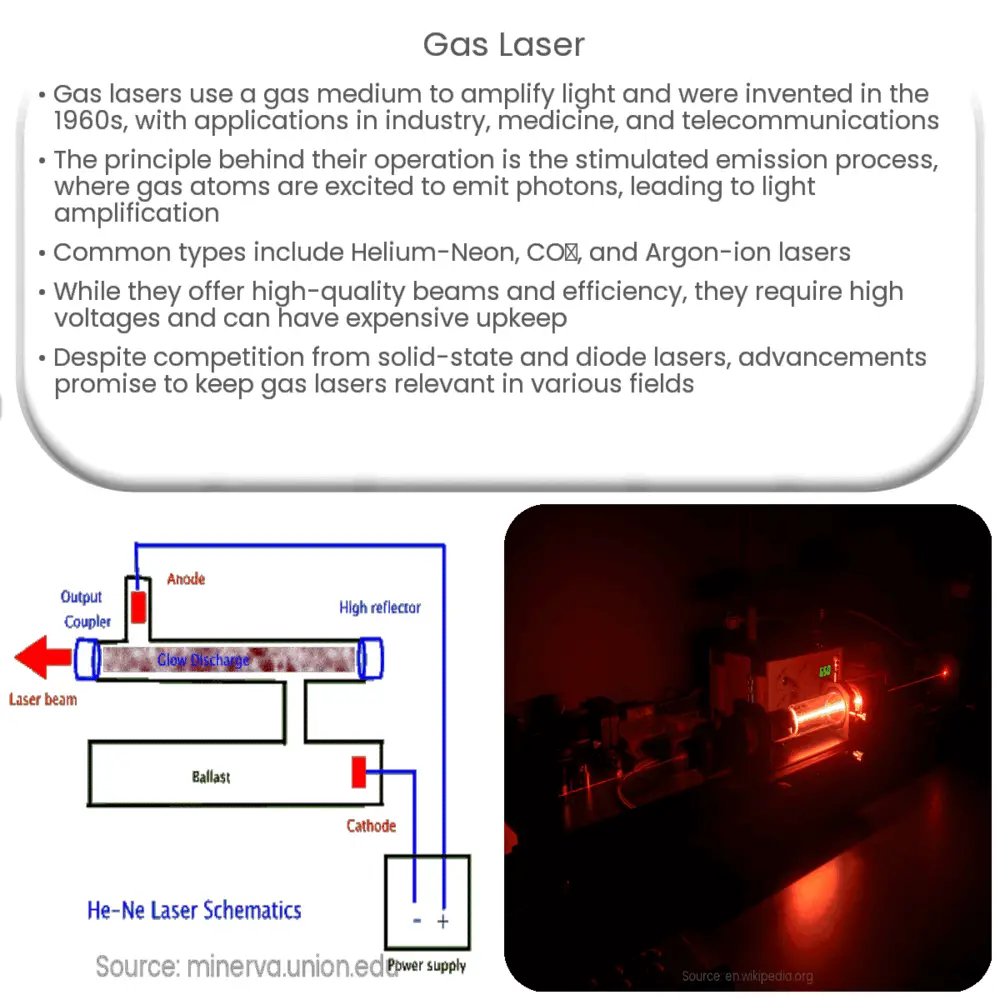Explore the world of gas lasers – their types, working principle, advantages, applications, and future prospects in this comprehensive guide.

Introduction to Gas Lasers
Gas lasers, as the name implies, are lasers that use a gas medium for the amplification of light. Since their invention in the 1960s, they have found broad application in numerous fields, including industry, medicine, and telecommunications.
The Basic Principle
At the heart of every laser is a process called stimulated emission, a term coined by Albert Einstein. This is the principle that enables a laser to emit light. In a gas laser, the active medium that produces this light is a gas or mixture of gases.
Types of Gas Lasers
- Helium-Neon Lasers: These are the most common gas lasers. They are typically used for demonstrations in educational settings due to their relatively low cost and the visible red light they produce.
- Carbon Dioxide Lasers: Also known as CO2 lasers, these are powerful infrared lasers commonly used in industrial applications, such as cutting and welding.
- Argon-ion Lasers: These lasers emit light in the ultraviolet to visible range and are frequently used in applications like holography, spectroscopy, and in some medical procedures.
How Gas Lasers Work
The operation of a gas laser starts with the excitation of the gas atoms. This is typically achieved through an electrical discharge, which boosts the atoms to a higher energy state. The excited atoms then decay to a lower energy state by emitting photons. If these photons encounter another excited atom, they can stimulate the atom to emit more photons of the same energy, direction, and phase – this is the ‘stimulated emission’ mentioned earlier. These photons are then reflected back and forth between mirrors, which form a resonant cavity, amplifying the light and producing the laser beam.
Advantages and Disadvantages of Gas Lasers
Gas lasers are known for their high efficiency and the ability to produce a high-quality beam with excellent spatial coherence. They also offer a wide range of output wavelengths. However, they also have downsides: they often require high voltages to operate, and gas refill can be expensive and complicated. Furthermore, some gases used in these lasers can be hazardous.
Applications of Gas Lasers
Gas lasers, due to their versatility and wide output wavelength range, find numerous applications in various sectors.
- Industry: High-power gas lasers like the CO2 laser are ideal for material processing tasks such as cutting, welding, and engraving. They are valued for their precision and efficiency in these applications.
- Medicine: In the medical field, gas lasers are used for a variety of procedures including laser surgery, skin treatments, and eye surgery. The precision and control they offer are critical in these sensitive applications.
- Scientific Research: Gas lasers have been instrumental in many scientific discoveries and continue to be valuable tools in research. They are used in spectroscopy, holography, and even in large-scale experiments like particle acceleration.
- Telecommunications: Some gas lasers, especially helium-neon lasers, are used in fiber-optic communication systems due to their excellent beam quality.
Future of Gas Lasers
While solid-state lasers and diode lasers have seen increased popularity due to their compact size and efficiency, gas lasers continue to be indispensable in many applications where their unique properties are required. Advancements in technology and the discovery of new gas mixtures promise to improve the efficiency, power output, and lifetime of gas lasers, ensuring their relevance in the future.
Conclusion
In conclusion, gas lasers, with their diverse types and wide range of applications, are a critical component of modern technology. Despite their challenges, their unique advantages in terms of beam quality and output wavelength range ensure they remain an active area of research and development. As technology continues to evolve, it is expected that new and improved gas lasers will continue to drive innovations in many sectors, from industry and medicine to telecommunications and scientific research.

